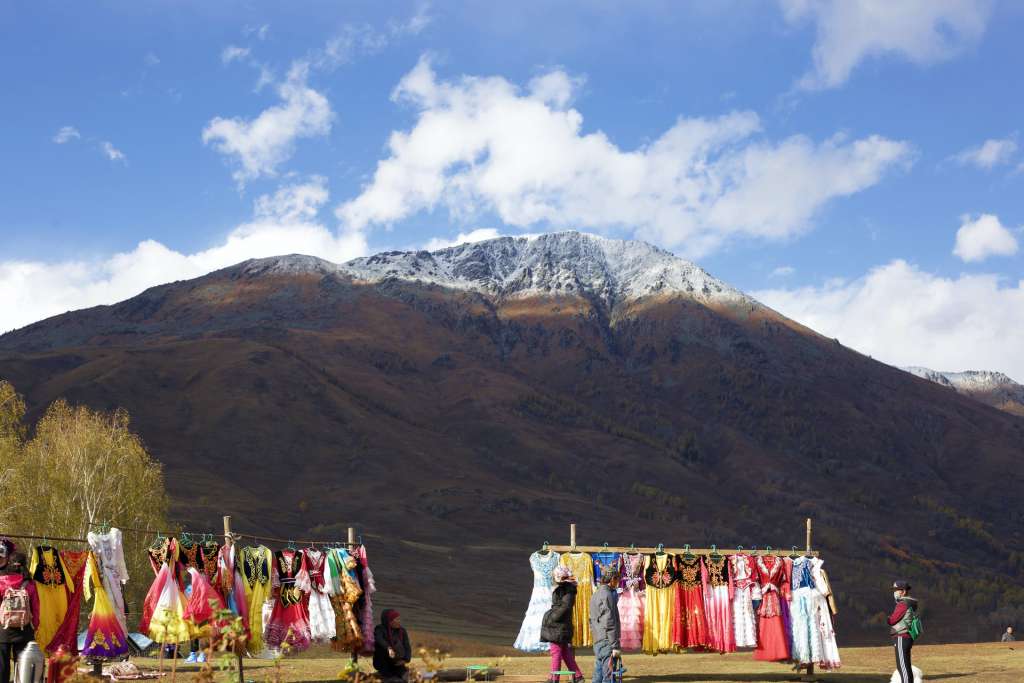Image above shows Kazakh horse meat sausage. Image by Marco Verch/ ccnull
YOU THINK YOU KNOW Chinese food? Adventurous young Chinese foodies are heading into the cold, remote highlands of the western region to find delicious new flavors. The bad news is that sometimes you have to decide which of your four-legged friends is your companion, and which is your dinner. Emily Zhou reports.
THESE DAYS WHEN we think of China, we often think of the high-rise skyscraper cities along the southeastern coast. But the vast land has so many different environments – including the massive rolling mountains of the west, dotted with snow on the high peaks, and flocks of cattle and sheep in the low valleys.
At the southern foot of the Altay Mountains (阿勒泰山脈), the Kazakhs (哈薩克族人) have been living and herding for thousands of years. Many still retain the traditional nomadic style of living of their ancestors. The only difference is the convenience they get these days: people can move to the warm “winter habitats” established by authorities when it starts getting cold.
One of several minority groups in Xinjiang, the Kazakhs have unique culinary habits which are little known outside their communities. More in touch with nature than modern people, they have different cuisines to eat in different seasons.

MOUTH WATERING MUTTON
On the high Altay plateau, the Kazakhs, sheep and weeds have maintained an ecological balance for thousands of years. The raising of sheep is not only the way that people earn their living, but also provides their main food source too. Braised lamb boiled in clear water is a summer delicacy for the Kazakhs. In the warmth, the sheep wandering on the plateau are strong and have meat which is firm but also tender, coming from lambs less than a year old.
The lamb is boiled in water without any other ingredients so that it can keep the original flavor of the meat, which is cooked slowly for hours and “melts in mouth”. After the meat is taken out from the big pot, it will be put in dishes or basins on the table surrounded by a big Kazakh family.

Kazakhs’ traditional meat-eating style is that they grab a piece of meat with their left hand and use a sharp knife in their right hand to cut the meat into slices which they eat one by one. Undoubtedly, Kazakhs are still eating in this traditional fashion nowadays.
FRIENDS OR FOOD?
Just three months after burning hot August, the plateau is covered by heavy snow. What comes with the cold weather is “winter slaughter”, which means herdsmen begin to kill the livestock and store a larger amount of meat to help everyone survive the long winter. The winter slaughter will involve a variety of livestock species, except for cows and sheep. Some horses and camels cannot survive the winters.
However, as we all know, horses and camels are the dominant means of transporting, moving and loading cargo in rural areas made up of plains and mountains.
Indeed, most of herdsmen in Altay treat their animals as friends or even family members. Then how do they bring themselves to kill the horses and camels during the winter slaughter?

In fact, herdsmen will divide the livestock into two groups according to their level of affection with them. The group they feel close to, will be treated kindly as friends, while the other animals will be set aside as reserves for winter slaughter.
Horse meat sausage plays a vital role in Kazakh recipes. Traditional meat storage methods, mainly by chilling, rather amazingly create foods with great flavor. In order to make the sacrifice of their horses meaningful, women and children living in the warmer “winter habitats” even come back to their own pastures to be helpers during this process.

Horse ribs with fatty and lean meat will be cut into loafs, carefully inserted into cleaned horse intestines, and hung in a yurt without any form of heating. At night, the temperature will rapidly drop to below -20 degrees Celsius. Covered by a layer of ice, the horse meat sausages are preserved by the cold.

When the sun rises, herdsmen light a fire under sausages, which will soon turn a caramel color. The flavor of the meat is locked in tightly by this method. Typically, the procedures will last about a month. The culinary delicacy known as the “smoked horse meat sausage” is exquisite food saved for visiting VIPs and for celebrating festivals.
SO MANY DIFFERENT CUISINES
It is widely known that “duration and degree of heating” (“火候”) is seen as the key element for the creation of Chinese cuisine. However, in remote areas of China like Altay, the taste of food is not exactly not made by the level of fire, by expensive ingredients, or by delicate cutting techniques.
Chinese people cook unique local cuisines according to regional weather, habits and religious beliefs. They end up creating delicious results which are welcomed by most people from other places. From storage to eating, each procedure contains wisdom and the spirit of hard work.

At sunset, you can watch from a distance as curled wisps of smoke gently rise up at the foot of the Altay plateau. The sight is a sign that Kazakh families are using ancient methods to cook their delicious foods for dinner.
